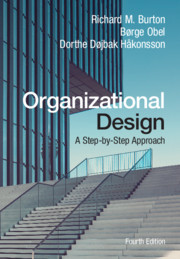Description
Organizational Design (4th Ed., Revised edition)
A Step-by-Step Approach
Authors: Burton Richard M., Obel Børge, Håkonsson Dorthe Døjbak
Now in its fourth edition, this comprehensive textbook uses a multi-contingency model to communicate the fundamentals of traditional and new organizational forms.
Language: English
Subject for Organizational Design:
48.38 €
In Print (Delivery period: 14 days).
Add to cart
Publication date: 07-2020
284 p. · 16.8x24.2 cm · Paperback
284 p. · 16.8x24.2 cm · Paperback
Description
/li>Contents
/li>Biography
/li>
Now in its fourth edition, this is the definitive step-by-step 'how to' guide to designing an organization. Building on information processing theory, the book proposes a holistic, multi-contingency model of the organization. This textbook communicates the fundamentals of traditional and new organizational forms, including up-to-date analysis of self-organizing, boss-less, digital, and sustainable organizations. Providing a framework for the practical implementation of organizational design changes, the authors break the process down into seven basic steps: (1) Assessing Goals, (2) Assessing Strategy, (3) Analyzing Structure, (4) Assessing Process and People, (5) Analyzing Coordination, Control and Incentives, (6) Designing the Architecture, and (7) Implementing the Architecture. Each step connects with one of the nine interdependent components of the multi-contingency model, and the authors also provide a logical query process for approaching each of these components. This is an ideal guide for managers or executives interested in assessing their organization and taking steps to redesign it for success, as well as for MBA and executive MBA students looking for an introduction to organizational design.
Step 1. Getting Started: 1. Assessing the scope and goals of the organization; Step 2. Assessing the Strategy: 2. Strategy; 3. Environment; Step 3. Analyzing the Structure: 4. Traditional configurations of the firm; 5. New organizational forms?; Step 4. Assessing Process and People: 6. Work, task design and agents; 7. Leadership and organizational climate; Step 5. Analyzing Coordination, Control, and Incentives: 8. Coordination and control; 9. Incentives; 10. Designing the structure and coordination; Step 6. Designing the Architecture: 11. Designing the architecture and the sequence of change; Step 7. Implementing the Architecture: 12. Implementing the change: who should do what when?
Richard M. Burton is Professor Emeritus of Organization and Strategy at The Fuqua School of Business, Duke University, North Carolina. Richard has published articles in journals including Organization Science, Management Science, Administrative Science Quarterly, and Strategic Management Journal, among others. He is the recipient of an honorary doctorate from Aarhus University, Denmark.
Børge Obel is a professor at the Interdisciplinary Center for Organizational Architecture, Department of Management, Business, and Social Sciences, Aarhus University, Denmark, and The European Institute for Advanced Studies in Management (EIASM), Brussels. Børge has published numerous academic papers in journals including Strategic Management Journal, Organization Science, ASQ, and Management Science.
Dorthe Døjbak Håkonsson is a professor at the Department of Management, Business, and Social Sciences, Aarhus University, Denmark, where she also serves as Center Leader of ICOA (the Interdisciplinary Center for Organizational Architecture). She is Associate Editor of the Journal of Organization Design, and a member of the board of the Organizational Design Community. Dorthe has published articles in journals including Strategic Management Journal, California Management Review, and Long Range Planning, among others.
Børge Obel is a professor at the Interdisciplinary Center for Organizational Architecture, Department of Management, Business, and Social Sciences, Aarhus University, Denmark, and The European Institute for Advanced Studies in Management (EIASM), Brussels. Børge has published numerous academic papers in journals including Strategic Management Journal, Organization Science, ASQ, and Management Science.
Dorthe Døjbak Håkonsson is a professor at the Department of Management, Business, and Social Sciences, Aarhus University, Denmark, where she also serves as Center Leader of ICOA (the Interdisciplinary Center for Organizational Architecture). She is Associate Editor of the Journal of Organization Design, and a member of the board of the Organizational Design Community. Dorthe has published articles in journals including Strategic Management Journal, California Management Review, and Long Range Planning, among others.
© 2024 LAVOISIER S.A.S.




